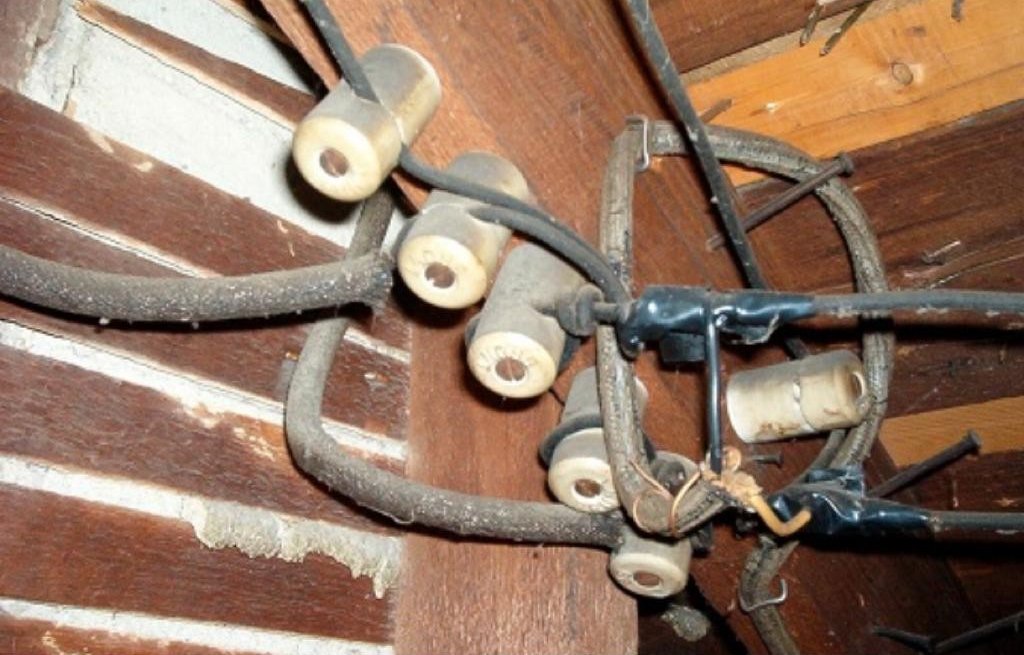Knob and tube wiring is characteristic of homes wired prior to the 1950s. Even though most jurisdictions don’t allow this residential electrical installation system in modern home building, it’s common in older homes. Knob and tube wiring is safe if not tampered with or professionally joined to modern wiring, but it’s important to understand some of the hazards associated with this system.
If you plan to buy a heritage-style home, you will likely find knob and tube wiring in the attic or basement, or it may be hidden and installed behind your walls. If visible, you may recognize wires running through porcelain tubes in the wooden floor joists; that’s what we’re talking about!
Those porcelain knobs you see keep the wires secure. A rubberized cloth fabric insulates the wires. Unlike modern wiring, knob and tube wiring doesn’t have a ground wire.
Problems with Knob and Tube Wiring
Since this form of wiring was prevalent prior to the 1950s, it was understandably designed to carry the lighter loads of fewer appliances. Fast forward to 2021, where we rely on computers, microwaves, televisions, washers, dryers, and more. We demand considerably more electricity to operate these modern appliances, many of which feature a third prong on their plugs and require a grounded circuit to function as per the manufacturer’s specification. Adding a three-pronged circuit to an ungrounded knob and tube system is not only against code, but it can pose a serious shock hazard since there is no path to the ground for the electricity to travel in the event of a fault!
Modern wiring uses plastic for insulation, whereas knob and tube wiring is surrounded by a rubber coating. Damage to knob and tube systems is caused from the heat and expansion and contraction when a larger than expected load of electricity runs through a wire and heats it up, then cools down once the load has stopped. This constant heating and cooling wears on the integrity of the wire since it was not designed to handle this high capacity. Then it becomes brittle, and the surrounding rubber insulation deteriorates leaving an exposed or unprotected wire, which then can lead to a fire hazard if continually used incorrectly.
Mechanical abuse can also lead to serious damage, increasing your risk of an electrical fire. If you’re planning to have your knob and tube system replaced by hiring a handyperson, this is a big mistake. Not only is against code for a handy man to perform any work on an electrical system, but any unfavourable mechanical alteration can impact the integrity of the rubber, leaving you at risk of dangerous, exposed electrical wire.
Here are other problems you may encounter with knob and tube residential wiring:
- Damage: Handyman fixes, gradual wear and tear, and the tendency of porcelain to crack can all damage a knob and tube system. Not to mention the fact that rubberized cloth insulation becomes brittle over time, exposing electrical wires.
- Alterations: How can ineffective handyman repairs cause damage to your knob and tube wiring? It is often unsafely spliced by home handy persons in the basement or attic during the replacement process. It is therefore imperative to source certified electricians for any electrical work in your home, including the replacement of your knob and tube system.
- Insulation over the wiring: This is potentially the most dangerous problem. The white and black wires run separately in this system, without a ground wire. When you install household insulation over knob and tube wiring, this is an accident waiting to happen. Knob and tube systems are rated at 60 degrees and if insulation is added it will cause the heat to reach a higher temperature than 60 degrees. This will cause the insulation to burn and become hazardous.
- Home Insurance: Due to the high-risk factor, obtaining home insurance is extremely difficult if you still have knob and tube wiring installed. All the more reason to get it replaced.
Replacing Your Knob and Tube Wiring
Like copper wiring, knob and tube wiring can last for decades. It’s advised, however, to have it replaced it by a licensed electrician, regardless of if the insulation appears intact. Brittle insulation can leave bare wires exposed overnight, which is an electrical fire waiting to happen.
The great news is that experienced electricians can rewire your system while you are living in your home using the least intrusive methods to run wires in behind the walls, causing minimum damage. And rewiring is probably not as expensive as you think. It is an investment in the value of your home which will increase by rewiring your residential electrical system. What’s more, most homes can be re-wired in as little as a few days.
The expenditure will depend on the property’s age, size, overall conditions, and other factors. Only a firsthand look by certified electricians specializing in residential electrical wiring can help you determine the exact amount. More importantly, you’ll benefit from the peace of mind knowing that you and your family are safe in your own home.
Your home insurance will likely decrease once your insurance provider is aware that you have a new electrical system installed. Peace of mind and more money in your pocket? What are you waiting for?
A quick inspection by Your Home ElectriciansTM who are certified, experienced, and ESA approved will not only save you money but will provide peace of mind, knowing your family and home are safe. Leave the identifying, removing and replacing of knob and tube wiring to the pros, call Your Home ElectriciansTM today 416-698-8100.




